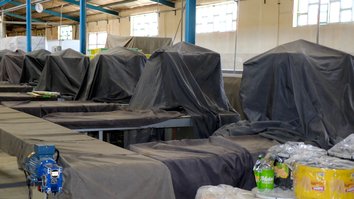PESHAWAR -- Shoddy ventilators made in China are a major factor in the growing number of deaths due to COVID-19 in Pakistan, doctors say.
"Faulty ventilators have been the major cause of deaths of several COVID-19 patients who required mechanical ventilation in intensive care units [ICUs]," said Dr. Rafiq Ahmed at the Saidu Teaching Hospital in Swat.
"The ventilators weren't of good quality, resulting in patients losing their lives," he added.
So far, 101 patients have died of the coronavirus in Swat, including 80 whom doctors put on Chinese ventilators, he said.
While ventilators are seen as crucial in helping critically ill coronavirus patients, China has made a mockery of the situation by selling substandard equipment, he said.
"China is making a huge amount of money from the COVID-19 pandemic by supplying substandard kits, personal protective equipment [PPE] and testing machines that cause more harm to patients than benefit," Ahmed said.
Prof. Noor Wazir, director of the COVID-19 ICU at the Hayatabad Medical Complex (HMC) in Peshawar, wrote to the Khyber Pakhtunkhwa (KP) Health Department on July 6, stating that he was outraged by the quality of ventilators supplied by China.
"I have been calling the company from which we purchased the ventilators, but they say that the government has no agreement for maintenance and repair," he said. "It is really frustrating because we are wasting taxpayers' money."
Other faulty equipment
So far the hospital has had 750 coronavirus patients, of whom 300 were put on ventilators, said HMC physician Jawad Shah. Of those, only 40 survived.
"We could have treated at least 90% of the patients if we had standard ventilators," he said. "One ventilator costs more than $30,000 [Rs. 5 million]. These are required for the most seriously ill patients. Chinese instruments, equipment, PPE and kits have adversely affected our response to COVID-19."
Besides pointing out the unacceptable ventilators, medical workers have made widespread complaints about deficient Chinese temperature guns, face masks and shoe coverings, he added.
He cited the inferior parts in the ventilators, which make it difficult to maintain a continuous flow of oxygen to patients.
So far 4,980 victims have died from the coronavirus in Pakistan, said Dr. Shah Zeb at the Ministry of National Health Services, Regulations and Co-ordination Islamabad.
Of those, 91% were hospitalised, while 9% died at home.
Fifty-seven percent of those who died in hospitals were on ventilators, he said.
"We have been reporting to the government about faulty ventilators because of high mortality among the ICU patients," he said. "About 75.3% of the deceased were 52 years old or older. They could have survived with better ventilators."
KP's biggest medical facility, Lady Reading Hospital, has 230 beds dedicated to coronavirus patients along with 33 ventilators.
Only nine of the most critically ill coronavirus patients have survived so far, said Dr. Shaukat Ali, who works at the facility's ICU.
The hospital has recorded 249 deaths from COVID-19.
"These ventilators stopped working at times when patients required mechanical ventilation," said Ali. "We have been complaining to the government about the issues, but now the government has started supplying local ventilators that are very good. We hope the rate of mortality from COVID-19 will drop."
Move to Pakistani devices
Pakistani ventilators are now reaching the hospitals in KP's various district headquarters, said KP Deputy Director of Health Dr. Umar Javid.
"So far, we have 400 ventilators, which we have installed in the 11 teaching hospitals that admit COVID-19 patients. Now, we will be able to admit COVID-19 patients in every district," he said.
The Ministry of Science and Technology and the Pakistani army have been training staff on how to properly operate the ventilators, Javid said. While there were serious issues with the Chinese ventilators, the Pakistani ventilators are easy to use, he added.
Pakistan is ramping up ventilator production, said Science and Technology Minister Fawad Hussain Chaudhry.
"We manufactured 12 ventilators in the initial phase completed on July 5, and now the production is about 250 per week," he said.
"We have been using the pandemic as an opportunity to strengthen our health system," Chaudhry said, adding that Pakistan intends to export ventilators in coming weeks.
A group of about 300 engineers are working on manufacturing the devices as well as teaching health professionals to operate them, he said.
"Pakistan has already started manufacturing masks, sanitisers and other equipment to fulfill its own needs and also export them," he added.
Unlike the Chinese ventilators, which are stationary, the Pakistani ventilators, approved by the US Food and Drug Administration (FDA) and the Pakistan Engineering Council, are portable and usable in ambulances or homes of patients, said Chaudhry.

![Doctors at Khyber Teaching Hospital in Peshawar July 12 observe a patient on a ventilator. [Ashfaq Yusufzai]](/cnmi_pf/images/2020/07/15/24961-kth-7-585_329.jpg)






